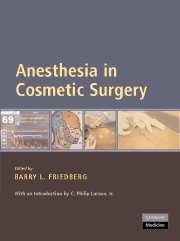Book contents
- Frontmatter
- Contents
- Foreword
- Acknowledgments
- Introduction
- Preface
- List of Contributors
- PART I MINIMALLY INVASIVE ANESTHESIA (MIA)Ⓡ FOR MINIMALLY INVASIVE SURGERY
- 1 Propofol Ketamine with Bispectral Index (BIS) Monitoring
- 2 Preoperative Instructions and Intraoperative Environment
- 3 Level-of-Consciousness Monitoring
- 4 The Dissociative Effect and Preemptive Analgesia
- 5 Special Needs of Cosmetic Dental Patients
- 6 Propofol Ketamine in the UK, Propofol Ketamine Beyond Cosmetic Surgery
- 7 Propofol Ketamine Beyond Cosmetic Surgery: Implications for Military Medicine and Mass-Casualty Anesthesia
- 8 Lidocaine Use and Toxicity in Cosmetic Surgery
- 9 Local Anesthetic Blocks in Head and Neck Surgery
- 10 Local Anesthetics and Surgical Considerations for Body Contouring
- PART II ALTERNATIVE ANESTHESIA APPROACHES IN COSMETIC SURGERY
- PART III OTHER CONSIDERATIONS FOR ANESTHESIA IN COSMETIC SURGERY
- APPENDIX A A Guide to Perioperative Nutrition
- APPENDIX B Reflections on Thirty Years as an Expert Witness
- Index
10 - Local Anesthetics and Surgical Considerations for Body Contouring
from PART I - MINIMALLY INVASIVE ANESTHESIA (MIA)Ⓡ FOR MINIMALLY INVASIVE SURGERY
Published online by Cambridge University Press: 22 August 2009
- Frontmatter
- Contents
- Foreword
- Acknowledgments
- Introduction
- Preface
- List of Contributors
- PART I MINIMALLY INVASIVE ANESTHESIA (MIA)Ⓡ FOR MINIMALLY INVASIVE SURGERY
- 1 Propofol Ketamine with Bispectral Index (BIS) Monitoring
- 2 Preoperative Instructions and Intraoperative Environment
- 3 Level-of-Consciousness Monitoring
- 4 The Dissociative Effect and Preemptive Analgesia
- 5 Special Needs of Cosmetic Dental Patients
- 6 Propofol Ketamine in the UK, Propofol Ketamine Beyond Cosmetic Surgery
- 7 Propofol Ketamine Beyond Cosmetic Surgery: Implications for Military Medicine and Mass-Casualty Anesthesia
- 8 Lidocaine Use and Toxicity in Cosmetic Surgery
- 9 Local Anesthetic Blocks in Head and Neck Surgery
- 10 Local Anesthetics and Surgical Considerations for Body Contouring
- PART II ALTERNATIVE ANESTHESIA APPROACHES IN COSMETIC SURGERY
- PART III OTHER CONSIDERATIONS FOR ANESTHESIA IN COSMETIC SURGERY
- APPENDIX A A Guide to Perioperative Nutrition
- APPENDIX B Reflections on Thirty Years as an Expert Witness
- Index
Summary
INTRODUCTION
A significant number of techniques for proper infiltration of local anesthetic for body contouring procedures can be summarized on three levels. First, establish preemptive analgesia and adequate vasoconstriction at all incision sites. Second, provide both anesthesia and vasoconstriction in all planes of dissection and manipulation. Third, facilitate vasoconstriction to all vascular beds supplying the surgical planes of dissection. The third objective is best accomplished by having an understanding of the musculocutaneous and fasciocutaneous vascular anatomy. In many cases, these vascular pedicles are in close proximity to the sensory nerves; but often, they need to be addressed as distinct anatomic areas. A significant amount of local infiltration occurs prior to the surgical scrub and preparation. This allows for an appropriate amount of time to elapse for adequate analgesia and vasoconstriction.
Breast augmentation, for example, is the second most requested surgical procedure in many aesthetic surgery practices. Although there is no dominant vascular supply to the breast (Maliniak, 1943), the main contributors are perforators from the internal mammary artery, the lateral thoracic artery, and intercostal vessels (Fig. 10-1). There are also perforators from the thoracoacromial and thoracodorsal vessels to the pectoralis major muscle. This understanding is important when performing either subglandular or submuscular augmentation mammoplasty with or without mastopexy.
The glandular tissue receives its sensory innervation from the lateral mammary rami of the third through sixth intercostal nerves and medial mammary rami of the second through sixth intercostal nerves (Fig. 10-3).
- Type
- Chapter
- Information
- Anesthesia in Cosmetic Surgery , pp. 106 - 111Publisher: Cambridge University PressPrint publication year: 2007



